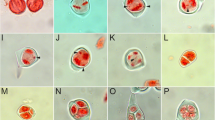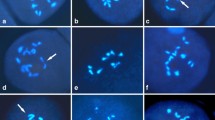Abstract
We analyzed anaphase I configurations and pollen viability in aposporous and sexual tetraploid (2n = 4x = 40) cytotypes of Paspalum notatum. Five natural aposporous accessions and three experimentally obtained sexual individuals were used. In addition, 16 (8 aposporous and 8 sexual) F1 hybrids, previously classified by their mode of reproduction, were analyzed. Cytogenetic observations revealed normal and abnormal anaphase I configurations in both aposporous and sexual genotypes. Anaphase I abnormalities were mainly laggard chromosomes, chromatin bridges, and micronuclei. On average, 44.36 % of aposporous meiocytes and 29.66 % of sexual ones showed abnormal anaphase I configurations. The total numbers of normal and abnormal anaphase I were highly significantly different between aposporous and sexual strains. The pollen viability test indicated that aposporous individuals had significantly more non-viable pollen than sexual ones; a positive correlation (r = 0.71; r 2 = 0.50) between the variables was detected. Analysis of aposporous and sexual hybrids confirmed differences in the numbers of normal and abnormal anaphase I patterns in the aposporous and sexual parents. However, similar proportions of viable pollen were produced by both groups of hybrids. In this case, the variables were not correlated (r = 0.23; r 2 = 0.05). Data from this study indicated that aposporous strains had a genetic rearrangement affecting meiosis that was absent in the experimentally obtained sexual individuals and that it was transmitted to the progeny. The possible association between meiotic abnormalities and the inheritance of apospory is discussed.


Similar content being viewed by others
References
Alexander MP (1980) Differential staining of aborted and non-aborted pollen. Stain Technol 44:117–122
Brown WV (1972) Inversions. In: Brown WV (ed) Textbook of cytogenetics. Mosby Company, Saint Louis, pp 196–206
Burton GW (1946) Bahia grass types. J Amer Soc Agron 38:273–281
Burton GW (1948) The method of reproduction in common Bahia grass, Paspalum notatum. J Amer Soc Agron 40:443–452
Burton GW (1967) A search for the origin of Pensacola Bahia grass. Econ Bot 21:319–382
Calderini O, Chang SB, de Jong H, Busti A, Paolocci F, Arcioni S, de Vries S, Abma-Henkens MHC, Klein Lankhorst RM, Donnison IS, Pupilli F (2006) Molecular cytogenetics and DNA sequence analysis of an apomixis-linked BAC in Paspalum simplex reveal a non-pericentromere location and partial microcolinearity with rice. Theor Appl Genet 112:1179–1191
Dahmer N, Schifino-Wittmann MT, Dall’Agnol M, de Castro B (2008) Cytogenetic data for Paspalum notatum Flüggé accessions. Sci Agric 65:381–388
Espinoza F, Daurelio LD, Pessino SC, Valle EM, Quarin CL (2006) Genetic characterization of Paspalum notatum accessions by AFLP markers. Plant Syst Evol 258:147–159
Felismino MF, Pagliarini MS, do Valle CB (2010) Meiotic behavior of interspecific hybrids between artificially tetraploidized sexual Brachiaria ruziziensis and tetraploid apomictic B. brizantha (Poaceae). Sci Agric 67:191–197
Forbes I, Burton GW (1961) Cytology of diploids, natural and induced tetraploids, and intraspecific hybrids of Bahia grass, Paspalum notatum Flüggé. Crop Sci 1:402–406
Gates RN, Quarin CL, Pedreira CGS (2004) Bahiagrass. In: Moser LE, Burson BL, Sollenberger LE (eds) Warmseason (C4) grasses. ASA, CSSA, and SSSA, Madison, pp 651–680
Madlung A, Tyagi AP, Watson B, Jiang H, Kagochi T, Doerge RW, Martienssen R, Comai L (2005) Genomic changes in synthetic Arabidopsis polyploids. Plant J 41:221–230
Martínez EJ, Urbani MH, Quarin CL, Ortiz JPA (2001) Inheritance of apospory in Bahia grass, Paspalum notatum. Hereditas 135:9–25
Martínez EJ, Hopp E, Stein J, Ortiz JPA, Quarin CL (2003) Genetic characterization of apospory in tetraploid Paspalum notatum based on the identification of linked molecular markers. Mol Breeding 12:319–327
Martínez E, Acuña C, Hojsgaard DH, Tcach M, Quarin CL (2007) Segregation for sexual seed production in Paspalum as directed by male gametes of apomictic triploid plants. Ann Bot 100:1239–1247
Mendes-Bonato AB, Junqueira-Filho RG, Pagliarini MS, Valle CB, Penteado MIO (2002a) Unusual cytological patterns of microsporogenesis in Brachiaria decumbens: abnormalities in spindle and defective cytokinesis causing precocious cellularization. Cell Biol Int 26:641–646
Mendes-Bonato AB, Pagliarini MS, Forli F, Valle CB, Penteado MIO (2002b) Chromosome number and microsporogenesis in Brachiaria brizantha (Gramineae). Euphytica 125:419–425
Mendes-Bonato AB, Ferrari Felismino M, Souza Kaneshima AM, Pessim C, Calisto V, Pagliarini MS, Borges do Valle C (2009) Abnormal meiosis in tetraploid genotypes of Brachiaria brizantha (Poaceae) induced by colchicine: its implications for breeding. J Appl Genet 50:83–87
Nogler GA (1984) Genetics of apospory in apomictic Ranunculus auricomus V. Conclusion. Bot Helvetica 94:411–422
Pupilli F, Martínez EJ, Busti A, Calderini O, Quarin CL, Arcioni S (2004) Comparative mapping reveals partial conservation of synteny at the apomixis locus in Paspalum spp. Mol Genet Genomics 270:539–548
Quarin CL (1992) The nature of apomixis and its origin in Panicoid grasses. Apomixis Newslett 5:8–15
Quarin CL, Burson BL (1983) Cytogenetic relations among Paspalum notatum var. saurae, P. pumilum, P. indecorum, and P. vaginatum. Bot Gaz 144:433–438
Quarin CL, Burson BL, Burton GW (1984) Cytology of intra and interspecific hybrids between two cytotypes of P. notatum and P. cromyorrhizon. Bot Gaz 145:420–426
Quarin CL, Espinoza F, Martinez EJ, Pessino SC, Bovo OA (2001) A rise of ploidy level induces the expression of apomixis in Paspalum notatum. Sex Plant Reprod 13:243–249
Quarin CL, Urbani MH, Blount AR, Martínez EJ, Hack CM, Burton GW, Quesenberry KH (2003) Registration of Q4188 and Q4205, sexual tetraploid germplasm lines of Bahia grass. Crop Sci 43:745–746
Quillet MC, Madjidian N, Griveau Y, Serieys H, Tersac M, Lorieux M, Bervilld A (1995) Mapping genetic factors controlling pollen viability in an interspecific cross in Helianthus sect. Helianthus. Theor Appl Genet 91:1195–1202
Rebozzio RN, Sartor ME, Quarin CL, Espinoza F (2011) Residual sexuality and its seasonal variation in natural apomictic Paspalum notatum accessions. Biol Plantarum 55:391–395
Rebozzio RN, Rodriguez MP, Stein J, Ortiz JPA, Quarin CL, Espinoza F (2012) Validation of molecular markers linked to apospory in tetraploid races of bahiagrass, Paspalum notatum Flüggé. Mol Breeding 29:189–198
Stein J, Quarin CL, Martínez EJ, Pessino SC, Ortiz JPA (2004) Tetraploid races of Paspalum notatum show polysomic inheritance and preferential chromosome pairing around the apospory-controlling locus. Theor Appl Genet 109:186–191
Stein J, Pessino SC, Martinez EJ, Rodrıguez MP, Siena LA, Quarin CL, Ortiz JPA (2007) A genetic map of tetraploid Paspalum notatum Flüggé (Bahia grass) based on single-dose molecular markers. Mol Breeding 20:153–166
Tischler CR, Burson BL (1995) Evaluating different Bahia grass cytotypes for heat tolerance and leaf epicuticular wax content. Euphytica 84:229–235
Young BA, Sherwood RT, Bashaw EC (1979) Cleared-pistil and thick-sectioning techniques for detecting aposporous apomixis in grasses. Can J Bot 57:1668–1672
Acknowledgments
The authors thank Florencia Galdeano for technical assistance. This study was financed by Agencia Nacional de Promoción Científica y Tecnológica, Argentina (PICT 2007 no. 00476); Consejo Nacional de Investigaciones Científicas y Técnicas (CONICET), Argentina (PIP 112-200801-01378), and Universidad Nacional de Rosario (AGR189). M. Podio, L.A. Siena, and D. Hojsgaard received fellowships from CONICET. C.L. Quarin and J.P. A. Ortiz are career members of CONICET.
Author information
Authors and Affiliations
Corresponding author
Rights and permissions
About this article
Cite this article
Podio, M., Siena, L.A., Hojsgaard, D. et al. Evaluation of meiotic abnormalities and pollen viability in aposporous and sexual tetraploid Paspalum notatum (Poaceae). Plant Syst Evol 298, 1625–1633 (2012). https://doi.org/10.1007/s00606-012-0664-y
Received:
Accepted:
Published:
Issue Date:
DOI: https://doi.org/10.1007/s00606-012-0664-y




